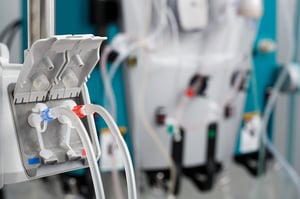Catheter Patient’s Treatment Is Optimized with Flow-QC Delivered Flow and Recirculation Tests
A 75-year-old female patient with a central venous catheter underwent a Flow-QC test with a Transonic Hemodialysis Monitor. Her blood lines were in a normal line position. The  pump setting on the hemodialysis machine was 290 mL/min. The Flow-QC test measured Delivered Blood Flow at 190 mL/min along with no recirculation.
pump setting on the hemodialysis machine was 290 mL/min. The Flow-QC test measured Delivered Blood Flow at 190 mL/min along with no recirculation.
The 35 percent disparity between machine’s pump setting of 290 mL/min and measured Delivered Blood Flow of 190 mL/min indicated that there was a significant risk of hemolysis.
The staff responded by first checking the lines to make sure that they were not kinked. Then they reversed the blood lines, reset the pump at 300 mL/min and remeasured Delivered Blood Flow and Recirculation with the Transonic Hemodialysis Monitor. This Flow-QC Test reported that Delivered Flow was now 290 mL/min and Recirculation was 2-3 precent. As a result, the patient received better treatment with the lines in a reversed position and the pump delivering 290 mL/min.
Although central venous catheters are known to be prone to thrombosis and infection, a majority of patients undergoing hemodialysis have catheters at some point in their treatment, either to initiate hemodialysis or for permanent hemodialysis delivery. KDOQI Guidelines recommend blood flow in catheters be maintained at more than 300 mL/min for adequate hemodialysis.
Delivery of the prescribed dose of dialysis closely correlates to the amount of blood cycled through the dialyzer and thus, to the rate of Delivered Blood Flow. The use of catheters for dialysis delivery has two potential pitfalls that can be avoided:
1. Tissue flap blocking the lumen of the catheter’s arterial entry port, impeding flow and causing a severe drop in dialysis dose delivery. This can be identified via the Transonic Hemodialysis Monitor’s Delivered Blood Flow Test and often corrected.
2. The close proximity of the catheter’s arterial entry and venous return ports make recirculation likely. If there is, for instance, 10 percent recirculation, the amount of blood cycled through the dialyzer is effectively 10 percent less and underdialysis can occur. This can be monitored and corrected via a Transonic Hemodialysis Monitor’s Recirculation Test.
REFERENCES
HDCatheters(DL-80-tn)RevC2013USltr
Hemmelgarn BR et al, Prevention of Dialysis Catheter Lumen Occlusion with rt-PA versus Heparin Study Group. “Prevention of dialysis catheter malfunction with recombinant tissue plasminogen activator,” N Engl J Med. 2011; 364(4): 303-12.
Moist LM et al, ”Relationship between blood flow in central venous catheters and hemodialysis adequacy,” Clin J Am Soc Nephrol 2006 Sep; 1(5): 965-71.




